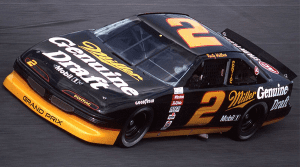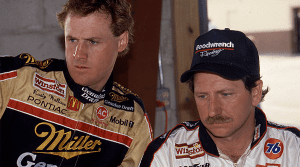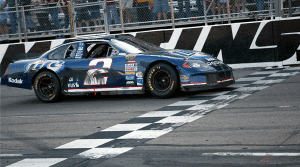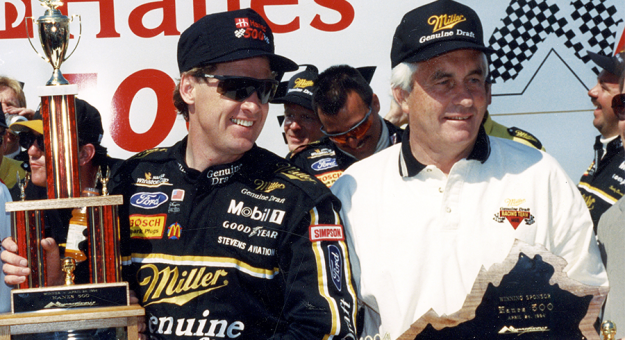Polarizing figures driving iconic race cars were a large reason NASCAR’s popularity skyrocketed during the 1980s through early 2000s.
During that time frame, race cars were very much like a brand for their driver. Dale Earnhardt was identified by the No. 3 Chevrolet, Jeff Gordon was known for his fluorescent rainbow-colored No. 24 Chevrolet and Rusty Wallace was identified with the No. 2 Miller Beer machine.
Wallace joined legendary team owner Roger Penske in 1991 to drive the No. 2. From there, plenty of history was made.
Of Wallace’s 55 wins in the NASCAR Cup Series, 37 came with ‘The Captain.’
Wallace’s road to glory wasn’t a smooth path at first. In his first Cup Series start in 1980, Wallace piloted a Penske-owned No. 16 Chevrolet sponsored by Penske Chevrolet at Atlanta Motor Speedway and finished second to Dale Earnhardt.
“We thought that right away, ‘Man my career’s gonna take off,’” Wallace told SPEED SPORT.
“But after that, he put me in a couple other races and I fell flat on my face. He said, ‘Man look, you need to go get some more experience and then we’ll hopefully get this thing back going later on.’”
Thus, Wallace sought out a new path for his career. The Missouri native’s first full-time ride came aboard the No. 88 Cliff Stewart Racing Pontiac in 1984.

Two seasons with Stewart eventually turned into an opportunity to drive the No. 27 for Blue Max Racing in 1986. Wallace quickly turned into a polished winner, scoring multiple victories for team owner Raymond Beadle en route to a Cup Series title in 1989.
With Beadle looking to exit the sport upon the conclusion of the 1990 season, Wallace’s next move was a phone call to Penske.
“I called him up a week later, I said, ‘Hey, Roger, I just won the championship, is that good enough?’ And he goes, ‘Hell yeah man, let’s start this team,’” Wallace recalled.
“I had a couple nice offers, but I said, ‘Man, Roger and I got to get together.’”
With the aid from former Penske Racing South President Don Miller, who spearheaded Penske’s return to NASCAR racing, Wallace was back under Penske power in 1991.
The Rise Of ‘Midnight’
During his legendary run with Penske, Wallace often refers to the famed “Midnight” chassis from 1993-’94 that was cheered by fans and feared by competitors.
“We built this amazing chassis that was 100-percent legal that just outperformed the rest,” Wallace said. “The car always handled great, I was able to lead a s—load of laps and run up front all the time with that car. So much so that the car got famous among the race fans.”
Midnight, Wallace’s black-and-gold No. 2 Miller Genuine Draft machine, went on quite the tear in 1993-’94. In the 38 races the chassis competed in, Wallace steered Midnight to 30 top-five finishes and 13 victories.
Despite Penske’s switch from a Pontiac Grand Prix to a Ford Thunderbird in 1994, Midnight was relentless.
Off the track, merchandise sales were through the roof.
“They had Midnight t-shirts and Midnight hats,” Wallace said. “We’d go to the race track and everybody would be chanting, ‘Midnight, Midnight, Midnight, is Midnight coming next week?’
“I’d win, say Richmond (Va.), and they’d go, ‘What car are you gonna bring next week? Are you gonna bring Midnight?’ So, Midnight got the crap ran out of it because it was such a good car.”
The Midnight era also gave Wallace his closest chance at giving Penske a Cup Series title during his tenure with the team. While 10 victories and 21 top-10 finishes in 30 races was stout, Wallace missed out on the championship by 80 points to Earnhardt.
As Wallace reflected on what could’ve been, consistency is what came to mind for the NASCAR Hall of Famer.
“When you needed that constant finishing with no mistakes, he was finishing these races with no mistakes,” Wallace said. “I might’ve been out there barn-burning it down and wanting to lead these things like crazy and winning these races.
“But, I was blowing some engines and I made some personal driver mistakes that really hurt us. The championship was awarded on consistency. I had a lot of wins, and we led a s—load of laps, but I screwed up on the consistency part.”
Changing of the Guard
While fierce battles raged between Earnhardt and Wallace during the latter half of the 1990s, a shift began to take place.
With the rise of Gordon in the No. 24 Chevrolet along with other stars such as Dale Jarrett and Mark Martin, it became crowded at the top of the sport.

With multiple drivers vying for wins and championships, it caught Wallace off guard as the competitive level reached new heights.
“It was a real eye-opener for me. It was the Dale and Rusty show for a long time in the ’90s,” Wallace said. “I was so used to getting a lot of this attention, and Earnhardt getting a lot of this attention.
“Us leading laps and upfront winning races. He’d win one week. I’d win the next week. Then all of a sudden, you see Dale Jarrett would win, and then this guy would win and that guy would win,” Wallace continued.
“But we were winning the majority of them, just no doubt about it, that’s just what was happening. Then all of a sudden, here comes this young guy Jeff Gordon with Rick Hendrick.
“All of a sudden all hell broke loose. I’m like, ‘Man, what’s going on here?’ It was hard for me to take that there was a new guy on the block that was kicking our ass.”
It was an alarming time for Wallace, however, the driver of the No. 2 remained steadfast in the heat of battle as he and Penske continued to churn out success in the growing sport.
“I just had to understand there was a new guy on the block,” Wallace said. “I had to appreciate the time that I had in the saddle of being on top of the game. It was great winning all those races in the ’90s.
“The ’90s it just took off, and then s—, I’m telling you what man, clear up to 2000 we were still getting it done. All the way from 1986 to the 2000s was so strong for me. It was just unbelievable.”
Among the highlights from that era was Wallace’s 50th career win at the famed Bristol (Tenn.) Motor Speedway in 2000, his ninth at the half-mile concrete oval. Wallace tied Cale Yarborough and Earnhardt for the second most wins at Bristol.
Knowing It Was Time To Retire
A shift in competition didn’t slow Wallace and the No. 2 crew as the world entered a new millennium in 2000.
Wallace ripped off four victories that season, which resulted in a seventh-place points finish.
Though the nearly 10-month grind year in and year out weighed heavily on Wallace as 2001 neared.
“I think it happened when I won several races, and I sat down and kept thinking, ‘I’m getting tired of being on the road all the time,’” Wallace recalled. “‘I’m constantly on the road, I’m not seeing my family as much as I want.’”
A week before the 2001 Daytona 500 at Daytona (Fla.) Int’l Speedway, a conversation with former NASCAR CEO Bill France Jr. gave Wallace further clarity on his future.
“Bill France Jr. asked me to come to his office in Daytona,” Wallace said. “I went to his office and he said, ‘I just want to let you know, I’ve watched your career and you’ve won everything in the world. Now I see you at the very peak of your career and you are almost starting to tumble down the hill a little bit now.

“’This sport can really use you in different ways besides being a race car driver. I don’t want you to get hurt out in one of these cars.’ He said, ‘You’ve done a lot for this sport and I don’t want you to get hurt.’”
A week after Wallace’s conversation with France, Earnhardt died in a crash on the final lap of the Daytona 500. Wallace rushed to the hospital after the event, where he learned the tragic news.
Alongside France that evening was a reminder for Wallace on how dangerous the sport can be.
“That night, Bill France looked me in the eye and was like, ‘I told you,’” Wallace recalled. “He was at the hospital with us and he said, ‘I told you.’”
It was at that moment Wallace’s perspective changed.
“That right there was what started my entry into retirement,” Wallace said. “It was the right thing.”
With a nod of approval from his team owner, Wallace announced on August 31, 2004, that he’d retire at the conclusion of the 2005 Cup Series season.
“Roger said, ‘You’ve done everything, I want you to stop,’” Wallace said. “When he supported it, it made me feel really, really good, because he’s one of the smartest people in the world.”
Wallace earned one more victory with Penske at the half-mile short track of Martinsville (Va.) Speedway in 2004.
The Impact Of Penske
The duo of Wallace and Penske will forever live on in NASCAR history as the sport continues to celebrate its 75th anniversary season.
As Wallace reflected on his time with Penske, the 66-year-old detailed the off-track impact Penske instilled in Wallace during their 14-year run together.
“He’s taught me a lot about just being buttoned up. Treating people great and really keeping your operations spick and span,” Wallace said. “First impression is a lasting impression. I can go on and on with these stories, but he molded me to what I am right now.
“He’s been such an amazing mentor, just a mentor like you can’t believe to me,” Wallace continued.
“I don’t get to talk to him as much as I used to now because I’m not driving a car and I’m doing my deal and he’s doing his deal, but when we do talk it’s pretty empowering conversations.”
When NASCAR hits the track for throwback weekend at Darlington (S.C.) Raceway on Saturday, Penske’s iconic No. 2 driven by Austin Cindric continues to carry on a legacy that was fostered by Wallace.
Follow @DHoffmanMedia22